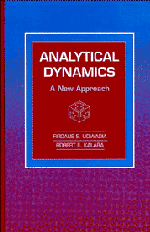Book contents
6 - THE FUNDAMENTAL EQUATION IN GENERALIZED COORDINATES
Published online by Cambridge University Press: 22 March 2010
Summary
In the last chapter we dealt with the use of generalized coordinates and the fundamental equation in generalized coordinates. While we did not present a proof of this equation (see equation (5.153)) we did provide some plausibility arguments in its favor. In this chapter we will prove this equation starting from the basic equation of analytical mechanics. We will amplify some of our observations related to the use of generalized coordinates, and provide more examples so that the reader acquires a greater familiarity with the concepts developed in the previous chapter through increased exposure.
We will utilize the fundamental equation, now stated in terms of generalized coordinates, to show how simple and elegant the determination of the equations of motion related to complex, constrained mechanical systems turns out to be. For this, we expand our compass of application to include rigid bodies, the description of their configurations and the determination of their kinetic energy through the use of Euler angles. We include in some detail the theory of rotations, and the concepts of infinitesimal rotations and angular velocity. Our treatment of rigid bodies may be somewhat swift for the reader who is completely unfamiliar with this topic; however, our main aim here is not to provide a comprehensive account of the kinematics and dynamics of rigid bodies; for this the reader may look at our “For Further Reading” list at the end of this chapter.
- Type
- Chapter
- Information
- Analytical DynamicsA New Approach, pp. 175 - 219Publisher: Cambridge University PressPrint publication year: 1996

